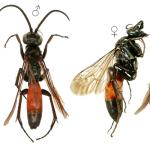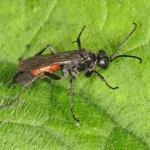A medium-sized red and black species, amongst the largest in its genus in Britain.This species, along with Arachnospila minutula, belongs to the subgenus Anoplochares, characterised by the female lacking a tarsal comb.The male has a characteristic genital plate.
Widely distributed in England,Wales and Scotland. Despite the comment in Day (1988), we are unaware of records from Ireland. Also present in the Channel Islands.
Occurs in northern and central Europe (Wolf 1972).
This species is not regarded as being scarce or threatened.
Day, 1988 is the standard work for identifying British Pompilidae. Wiśniowski, B., 2009 is also useful.
It occurs in a range of habitat types, including those on heavier soils. Sites from which it has been recorded include heathland, open woodland and coastal locations. In the south-east it is one of the more frequent species on chalk grassland.
Probably univoltine; occurring from mid-May to August, with a peak in June and July.
In Europe it has been recorded preying on the wolf spiders, Alopecosa pulverulenta and Trochosa terricola (Lycosidae) (Adlerz 1910).
The female lacks a tarsal comb and, so, is not adapted to digging its own burrow. Instead it attacks female spiders within their nesting burrows.The burrow entrance is partially blocked with vegetable material, after which the female wasp enters the burrow and stings the spider.The spider is only lightly paralysed and as the wasp larva eats it she often eats her own eggs.The period from egg-laying to construction of the pupal cocoon can be as little as fourteen days (Adlerz 1910).
No data is available.
No data available.



